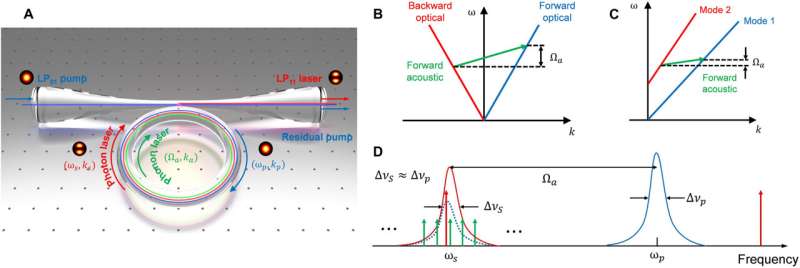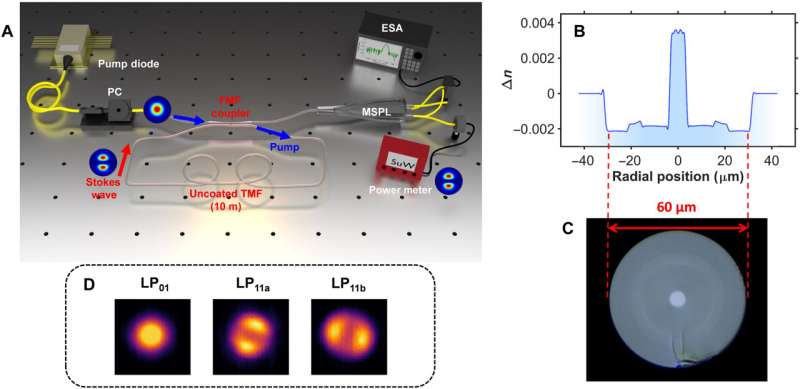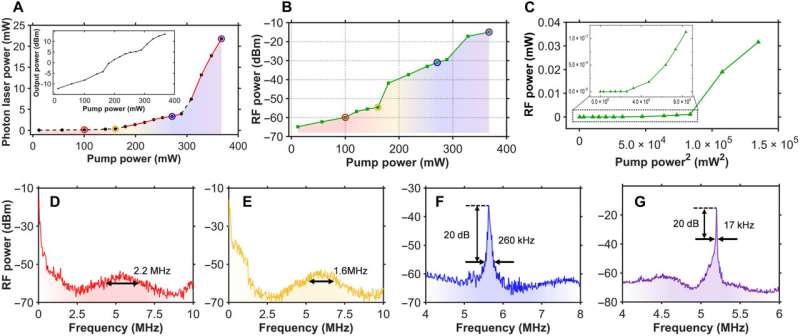
Lasers are a significant historical invention with ubiquitous impact in society. The concept also has interdisciplinary applications as phonon lasers and atom lasers. A laser in one physical domain can be pumped by energy in another. Nevertheless, all lasers demonstrated in practice have only lased in one physical domain thus far.
In a new report published in Science Advances, Ning Wang and a research team at the College of Optics and Photonics at the University of Central Florida, U.S., and the Prysmian group in France demonstrated the simultaneous process of photon and phonon lasing. The two-domain laser has multiple applications as optical and acoustic tweezers to conduct mechanical sensing to generate microwaves and perform quantum processing. The team expects this demonstration to open new paths for multidomain laser-related applications.
Developing a two-domain laser
Lasers are an extension of electronic oscillators at radiofrequencies and masers at micro-frequencies in the optical region. Lasers have tremendous applications with new extensions of the concept across domains such as acoustic oscillators, also known as sasers, and oscillators at atom or matter waves. The concept of laser traditionally describes an optical oscillator based on stimulated emission, although the term phonon laser and atom/matter laser are also quite common.
There are a few applications in which the process of simultaneous photon and phonon lasing can be useful. These include the development of acoustic tweezers at the sub-millimeter scale. Combined ultrasonic and photonic biological imaging for improved imaging quality and two-domain lasers have scope across quantum information processing and sensing. Existing demonstrations have shown the Stokes optical acoustic wave to be a byproduct in a phonon laser. In this work, Wang and colleagues developed a system of coupled oscillators that lased in two distinct physical domains pumped from the same source to show how the two-domain concurrent photon and phonon lasing enhanced output powers of both photon and phonon lasers.

Principle-of-action
The team generated the low-frequency flexural acoustic wave using forward stimulated Brillouin scattering; the interaction of photons and phonons within a two-mode fiber. The low-frequency phonons were confined in the silica fiber with a long lifetime of 10 milliseconds. The propagation length approximated 10 meters, allowing phonons to lase as well. In the experimental setup, the coherent oscillation of the optical wave enhanced the gain of acoustic phonons and vice versa, to generate lasing in two domains.
The team noted four states of function in the device by increasing the optical pump power to produce photon and phonon lasing for which the gains for both Stokes optical wave and the acoustic wave had to exceed their losses. The experimentalists devised a method to allow phonon energy within the ring cavity to facilitate phonon lasing. While the phonon laser power was confined inside the cavity, the Stokes optical laser was seen at the output of the coupler.
The experiments
During the experiments, the researchers used a 976 nm fiber coupled pump diode with a maximum output power of 400 mW. They used a thermoelectric cooler to regulate the functional temperature of the system. The pump launched into a two-mode fiber coupled into the outer diameter ring cavity.
The scientists used a reduced cladding 2-mode fiber made of pure silica cladding and a germanium-oxide doped, silica core. Since the acoustic fields extended into the entire cladding, the process of reducing the two-mode fiber cladding size improved the overlap between acoustic and optical fields to increase the stimulated Brillouin scattering gain coefficient.

Laser power
The team measured the phonon laser output power as a function of pump power injected into the ring cavity to obtain two thresholds corresponding to the photon laser and phonon laser. The threshold pump power of the photon laser was 180 mW. When they increased the pump power to 308 mW, the phonon laser started lasing, as well.
The measured threshold pump power and output laser power agreed with the outcomes of the numerical simulation results. The photon–phonon laser represented an inverted dissipative hierarchy, where the acoustic emission linewidth was much narrower than the pump laser linewidth when compared to existing standards.
Outlook
In this way, Ning Wang and colleagues showed how two coherently coupled lasers in different physical domains performed a variety of practical tasks. Light and sound have distinct space and time properties, and interact differently with materials; therefore, their availability can be explored differently. This phenomenon of coupled lasing in two different physical domains within the same cavity is a first-in-study outcome. This outcome goes beyond already established methods which include coherently coupled lasers such as laser-diode arrays.
The two-domain laser explored forward intermodal stimulated Brillouin scattering to enable coupling for concurrent photon and phonon lasing within the same cavity. The team did not directly observe phonon laser power in this study due to the absence of high-resolution and high frame-rate cameras. The scientists observed several regimes of laser functionality relative to spontaneous Brillouin scattering, photon lasing, and photon-phonon lasing, which aligned with the theoretical model of 2-domain lasing. The outcomes can lead to future advances in optomechanics and will usher in multidomain lasers and related applications.
More information: Ning Wang et al, Laser 2 : A two-domain photon-phonon laser, Science Advances (2023). DOI: 10.1126/sciadv.adg7841
Robert M. Pettit et al, An optical tweezer phonon laser, Nature Photonics (2019). DOI: 10.1038/s41566-019-0395-5
Journal information: Nature Photonics , Science Advances
© 2023 Science X Network

